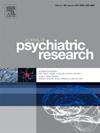Home-based transcranial direct current stimulation for major depressive disorder: 6-month follow-up from randomised sham-controlled trial and open-label treatment phases
IF 3.7
2区 医学
Q1 PSYCHIATRY
引用次数: 0
Abstract
Transcranial direct current stimulation (tDCS) is a potential home-based treatment for major depressive disorder (MDD). In our double-blind randomised controlled trial (RCT) (n = 174; UK and USA), a 10-week course of home-based tDCS demonstrated clinical efficacy (clinical response: 58.3 % active treatment arm and 37.8 % sham (p = 0.017). tDCS was delivered in a bifrontal montage, with anode over left dorsolateral prefrontal cortex (DLPFC) and cathode over right DLPFC. Each session was 30 min, with active stimulation at 2 mA and sham at 0 mA, incorporating brief ramp-up and ramp-down phased. Following the 10-week RCT, all participants were offered active tDCS in a 10-week open-label treatment phase, with 111 participants completing this phase. UK cohort (n = 77 MDD) were invited for additional 3-month and 6-month follow-ups, extending the total study period to 11 months post-randomisation. Participants were able to continue using the tDCS device during follow-up. At least one follow-up visit was attended by 42 MDD participants (27 women). Device usage rates were 59 % at 3-month follow-up and 55 % at 6-month follow-up. Clinical response rate was 64 % at 3-month follow-up and 76 % at 6-month follow-up. Among participants who had shown a clinical response after the open-label phase, 90 % maintained their response at the 6-month follow-up. In summary, long-term follow-up showed high and sustained clinical response rates regardless of continued tDCS device use.
家庭经颅直流刺激治疗重度抑郁症:随机对照试验和开放标签治疗阶段的6个月随访
经颅直流电刺激(tDCS)是一种潜在的家庭治疗重度抑郁症(MDD)的方法。在我们的双盲随机对照试验(RCT)中(n = 174;英国和美国),10周的家庭tDCS疗程显示出临床疗效(临床反应:积极治疗组为58.3%,假治疗组为37.8% (p = 0.017)。tDCS采用双额蒙太奇方式,正极位于左背外侧前额叶皮层(DLPFC)上,正极位于右背外侧前额叶皮层上。每次30分钟,主动刺激2 mA,假刺激0 mA,包括短暂的上升和下降阶段。在为期10周的随机对照试验之后,所有参与者在为期10周的开放标签治疗阶段接受积极的tDCS治疗,111名参与者完成了这一阶段。英国队列(n = 77 MDD)被邀请进行额外的3个月和6个月的随访,将随机化后的总研究期延长至11个月。在随访期间,参与者可以继续使用tDCS装置。至少有42名重度抑郁症参与者(27名女性)参加了一次随访。随访3个月时设备使用率为59%,随访6个月时为55%。3个月的临床有效率为64%,6个月的临床有效率为76%。在开放标签期后表现出临床反应的参与者中,90%在6个月的随访中保持了他们的反应。总之,无论是否继续使用tDCS装置,长期随访均显示高且持续的临床缓解率。
本文章由计算机程序翻译,如有差异,请以英文原文为准。
求助全文
约1分钟内获得全文
求助全文
来源期刊

Journal of psychiatric research
医学-精神病学
CiteScore
7.30
自引率
2.10%
发文量
622
审稿时长
130 days
期刊介绍:
Founded in 1961 to report on the latest work in psychiatry and cognate disciplines, the Journal of Psychiatric Research is dedicated to innovative and timely studies of four important areas of research:
(1) clinical studies of all disciplines relating to psychiatric illness, as well as normal human behaviour, including biochemical, physiological, genetic, environmental, social, psychological and epidemiological factors;
(2) basic studies pertaining to psychiatry in such fields as neuropsychopharmacology, neuroendocrinology, electrophysiology, genetics, experimental psychology and epidemiology;
(3) the growing application of clinical laboratory techniques in psychiatry, including imagery and spectroscopy of the brain, molecular biology and computer sciences;
 求助内容:
求助内容: 应助结果提醒方式:
应助结果提醒方式:


